“It's very hard to invest in coal [because of Kyoto], nuclear's a sort of four letter word... hydro is suddenly becoming too hard... what's left? ...we can't do everything on windpower.”
– Alan Jenkins, Electricity Networks Association, 2006
ELECTRICITY IS THE LIFEBLOOD of every industrial country. Electrical power allows human beings to multiply their relatively feeble muscular strength many times, putting that enormous productive power to use in transforming our world to make it a better place in which to live. Says George Reisman:
It is vital to recognize the enormous contribution that the essential vehicle of economic progress, namely industrial civilization, has made to human life and well-being since its birth over two centuries ago in the Industrial Revolution.
Industrial civilization has radically increased human life expectancy: from about thirty years in the mid-eighteenth century to about seventy-five years today. The enormous contribution of industrial civilization to human life is [dramatically] illustrated by the fact that the average newborn American child has a greater chance of living to age sixty-five than the average newborn child of a nonindustrial society has of living to age five. These marvelous results have come about because of an ever improving supply of food, clothing, shelter, medical care, and all the conveniences of life . . .
In the last two centuries, loyalty to the values of science, technology, and capitalism has enabled man in the industrialized countries of the Western world to put an end to famines and plagues, and to eliminate the once dread diseases of cholera, diphtheria, smallpox, tuberculosis, and typhoid fever, among others. . .
As the result of industrial civilization, not only do billions more people survive, but in the advanced countries they do so on a level far exceeding that of kings and emperors in all previous ages . . .
Trade and the fruits of industrial civilization beat all the conquests made by all the kings and emperors throughout all history into a cocked hat. At the most concrete level, the root of the success of industrial civilisation has been making it possible to multiply and direct our own muscular strength exponentially to produce what's needed to make our lives better. For an industrial country, electrical power is not a luxury, it is a necessity.
 Technology is man's means of staying alive. Human existence without technology is characterised by squalor, disease, plagues, starvation, drudgery, and helplessness in the face of natural disasters. This is the state to which the eco-freaks would return us.
Technology is man's means of staying alive. Human existence without technology is characterised by squalor, disease, plagues, starvation, drudgery, and helplessness in the face of natural disasters. This is the state to which the eco-freaks would return us.
When you look at the change in average life expectancy since James Watt invented his steam engine and Richard Arkwright installed them in his cotton mills -- from thirty-five years of age then to well over seventy now -- you might realise that everyone over the age of thirty-five now owes their lives to technology, and to the Industrial Revolution that made it possible.
TECHNOLOGY THESE DAYS NEEDS ELECTRICAL power (and most reliable electrical power is still generated by steam). Nationally, the demand for power is growing by 150MW per year. The graph below charts that rise.
Note that the primary growth is not in residential demand, but in industrial demand -- in supplying power to produce new wealth -- which puts into context the claims from sandal wearers that if we all turn off a few lights and have a cuddle our power problems will all go away.
They won't.
As it happens, over the years from from 1980 to 1998, the growth in New Zealand's generating capacity matched the growth in demand, growing at an averaged rate of about 150MW per year. Despite this, regular power shortages such as the famous outages of 1992 showed that even at this time capacity was near its limits -- partly because of the lack of backup generation for the occasionally fickle hydro generators.
What has changed since then is the National Party's introduction of the Resource Management Act (which was introduced in 1993) and the signing of the Kyoto Protocol by National in 1998, which was ratified by Labour in 2002. The former made the construction of new generating infrastructure all but impossible; the latter (which under David Parker comes with an Emissions Limiting Scheme and a ten-year moratorium on the construction of new thermal power stations) makes the construction of any serious generating capacity immoral. Together they make an anti-industrial dream team that has made every anti-industrialist in the country red-eyed with excitement.
As I said here last week, energy demand in New Zealand has increased at an annual rate of roughly 150MW, but, since the onset of the anti-industrial dream team, energy generation hasn't. Energy generators have wanted to produce more power, but for the most part they haven't been allowed to. We've enfeebled ourselves by a lack of industry's lifeblood. The table below shows the slowing of capacity growth:
Have a look at what's been built since the Resource Management Act was launched by National's Simon Upton in 1993, (arranged from north to south):
Now, looked at baldly that looks pretty impressive, doesn't it.
TOTAL NEW CAPACITY 1993 - 2008 = 1850.5 MW .
That's almost 125MW per year for the last fifteen years. You can see how that capacity was used over the last year in this graph showing the contributions of each of those thermal power producers over the last few years [e3p and HLY p40 are the new Huntly additions):
So, 125MW per year, mostly from new thermal stations like Taranaki's Combined Cycle Station, Huntly's new gas and co-generation plants, and the Otahuhu B station (Pete Hodgson's new Whirinaki station is just too expensive to run). Not quite the 150MW demanded (nor quite the figure claimed by an 'Insider' here last week.)
We could even go back to 1990 if we like and add the Clyde dam, finally commissioned in 1992, contributing 432 MW to the grid (giving us a total of 2282.5 MW, or 127 MW/year new capacity from 1990 to now). But all this new power production must be balanced against those plants that were decommissioned, either because they were too old, too inefficient, or just too damned expensive to run.
POWER STATIONS DECOMISSIONED 1990-2008:
New Plymouth, 2007 (580 MW)
Stratford, 1999 (200 MW)
Marsden A, 1992 (114 MW)
Otahuhu A, 2002 (90 MW)
Whirinaki ‘a’, 2002 (216 MW)
Meremere, 1990 (133)
TOTAL DECOMISSIONED 1990-2008: (1333 MW)
TOTAL NETT NEW CAPACITY SINCE 1990: 949.5 MW
That's pathetic. Looked at like this, we can see just how sick we are. If we'd kept up with demand we'd have produced over 2700 MW of new capacity. Instead, we have just one third of that.
Here's what we relied on last month (Waikato, Tongariro, Waitaki, and Clutha are the four main hydro contributors to add to the thermal production shown in the previous graph):
And just look at what we could have built. In recent weeks we've heard about the ban on new thermal power stations, and in recent years we've heard the Environment Court and the High Court knocking back and delaying Resource Consents for several high profile projects, and killing stone-dead the planning of many more we'll never know about:
Projects Abandoned/Delayed/Restricted due to Resource Management Act :
· Project Aqua, hydro (520 MW) - abandoned 2000-2004
· Marsden B, coal (320 MW) - abandoned 2007
· Wairau Valley, Marlborough, hydro (75 MW) - abandoned 2007
· Whanganui/Tongariro, hydro – Environment Court effectively reduced the Tongariro capacity by one-third due to the “mauri” of the Whanganui river …
· North Bank Tunnel, hydro (260MW) - delayed until at least 2016
· Makara, wind - reduced from 210 to 140MW in 2007
· Project Hayes, wind (150MW) - still in delay
· Te Uku Wind (72MW) - awaiting consents
· Te Waka Wind (111MW) - consent overturned by Environment Court in April, 2007
Leaving aside the effect on the Tongariro catchment of restricting water flow from the Whanganui, which is difficult to quantify, this looks like 1580 MW of power generation that we could have producing power now ... if it weren't for the Resource Management Act.
This is just some of the 'surplus capacity' that energy analysts in the late nineties were beginning to talk about coming on stream, and it hasn't. This is surplus capacity that hasn't come on stream, and in most of these cases never will come on stream. (Instead of this, we have one line of the dirty, asbestos-ridden hulk of New Plymouth's burner cranked up one more time to try and avoid the election-year ignominy of a shortage of electrical power bringing down those with political power).
The result of this undercapacity was only noticed by government last week when the power went off in the Beehive, but that rest of us have already seen it in news last week that factories from Bluff to Auckland aren't just switching off heaters and changing a few lightbulbs, they're already running fewer shifts and producing less wealth, all because of the parlous state of the present system, and with no new real generation capacity in sight beyond a few windmills.
This is what it means when we say that the effects of global warming are already upon us: the effects, that is, of government throttling industry to keep our Kyoto commitments.
Fact is, we either meet that increasing annual demand of 150MW per year, or we make ourselves poorer. If we're going to have any show of meeting that continually increasing demand -- which means, to remain as an industrial economy -- we need to build new power now.
Which means putting paid now to the Resource Management Act, and abandoning urgently the commitments we've made under Kyoto to throttle ourselves and our energy production.
UPDATE: Some arithmetic errors amended, Thursday 6 June, 9:10am.
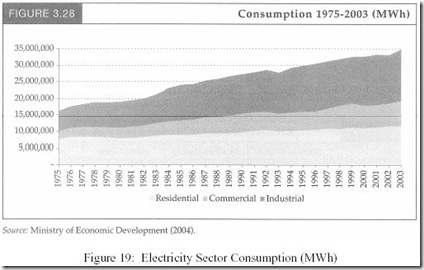
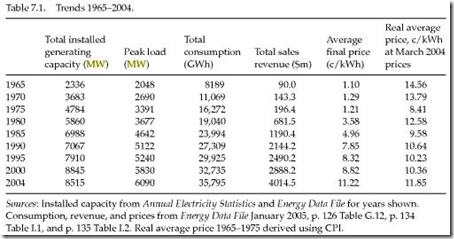
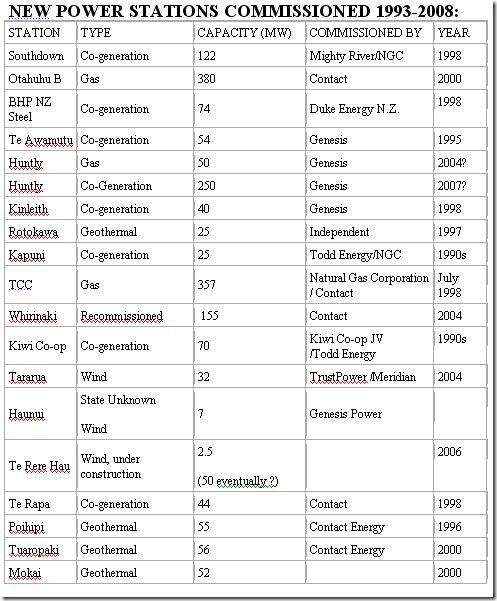
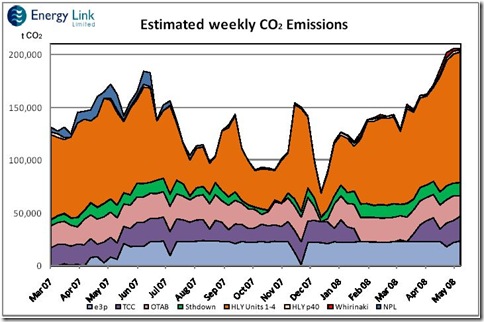
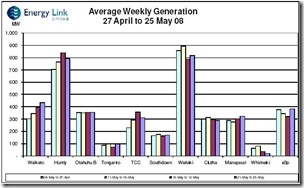

6 comments:
Great article PC.
"The root of production is man’s mind; the mind is an attribute of the individual and it does not work under orders, controls and compulsion, as centuries of stagnation have demonstrated. Progress cannot be planned by government, and it cannot be restricted or retarded; it can only be stopped, as every Statist government has demonstrated.
- Ayn Rand
Progress cannot be planned by government...
And yet, you still think that it is progress when the government disallowed the Canadian Pension Funds from buying shares in Auckland International Airport?
Great post PC, and well researched.
Julian
Interesting article and goes along way to giving an understanding and visual display of the near historical power generation and demand in NZ.
For the figures given in Table 7.1 for 1965 to 2004 and as an indication at peak power times (when restrictions are most likely to occur) the inbuilt factor of safety against demand meeting generating capacity can be seen here by dividing Generated Capacity by Peak Load:
Year 1965 – 2336/2048 = 1.41
Year 1970 – 3683/2690 = 1.37
Year 1975 – 4784/3391 = 1.41
Year 1980 – 5860/3677 = 1.59
Year 1985 – 6988/4642 = 1.50
Year 1990 – 7067/5122 = 1.38
Year 1995 – 7910/5240 = 1.51
Year 2000 – 8845/5830 = 1.52
Year 2004 – 8515/6090 = 1.40
As can be seen there has been an up and down fluctuation to reserve capacity due, as indicated in the article, to the building and removing of generating capacity with year 2004 showing a marked decrease in reserve capacity to meet Peak Load. I do not know just what the ideal factor of safety is here but from the figures above 1.6 would appear to be relevant. Since no indicative figures have been presented beyond 2004 we can only assume this F of S can only have become ever more critical.
Sorry to nit-pick but if I understand it correctly there appears to be an arithmetical error in the Total Nett New Capacity Since 1990 figure of 956.5 MW.
“We could even go back to 1990 if we like and add the Clyde dam, finally commissioned in 1992, contributing 432 MW to the grid (giving us a total of 2822.5 MW” –
the figure 2822.5 MW should read 2282.5 MW (1850.5 MW + 432 MW) and with the power stations decommissioned for the period 1990 – 2008 being 1333 MW this would make the Total Nett New Capacity since 1990: 949.5MW (2282.5-1333 = 949.5 MW) a figure even more on the pathetic side.
Thanks again for the informative article
Thanks everyone for your comments, and especially Serum for checking the sums. (Nitpicking like that I always appreciate.)
I've amended the figures you pointed out. Thanks again.
Post a Comment